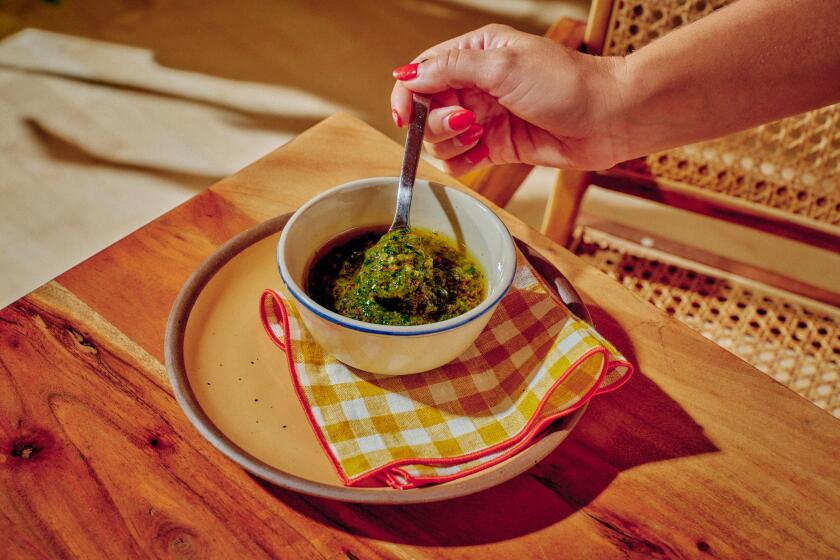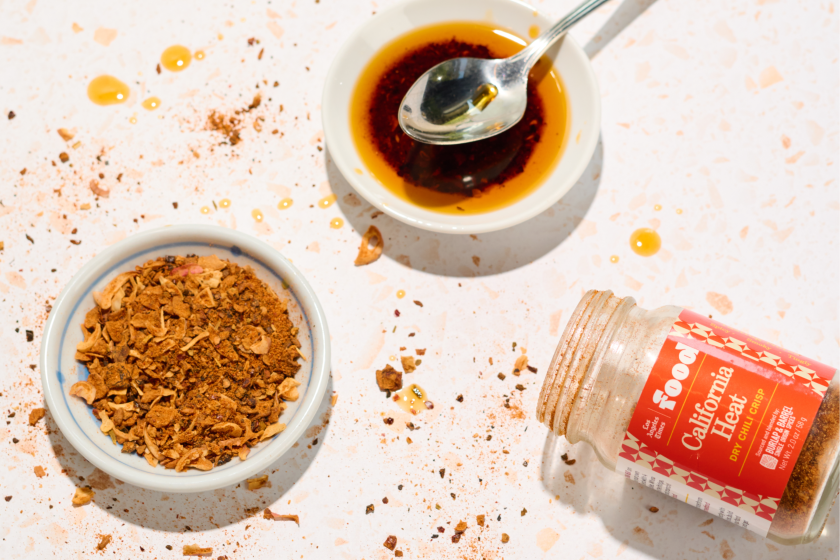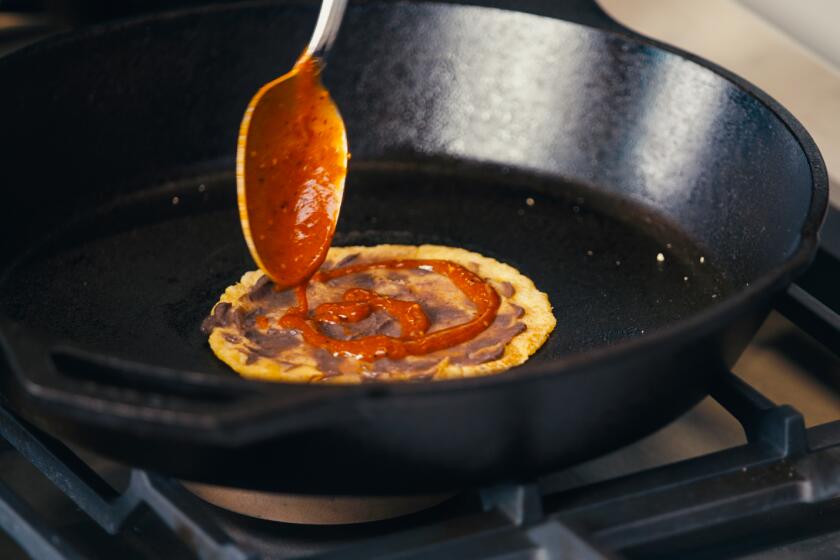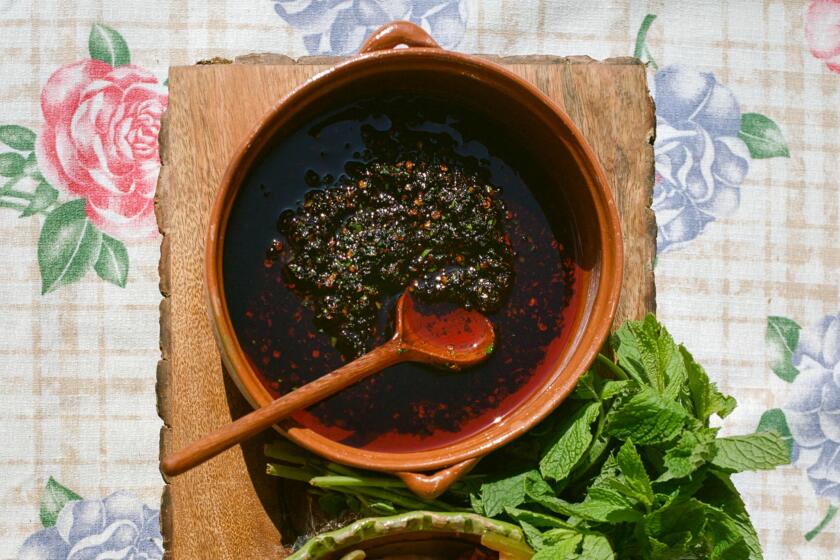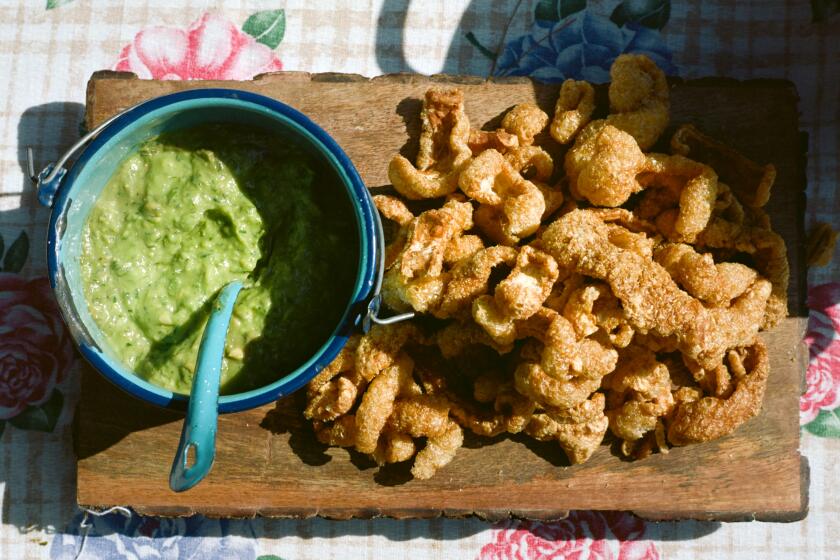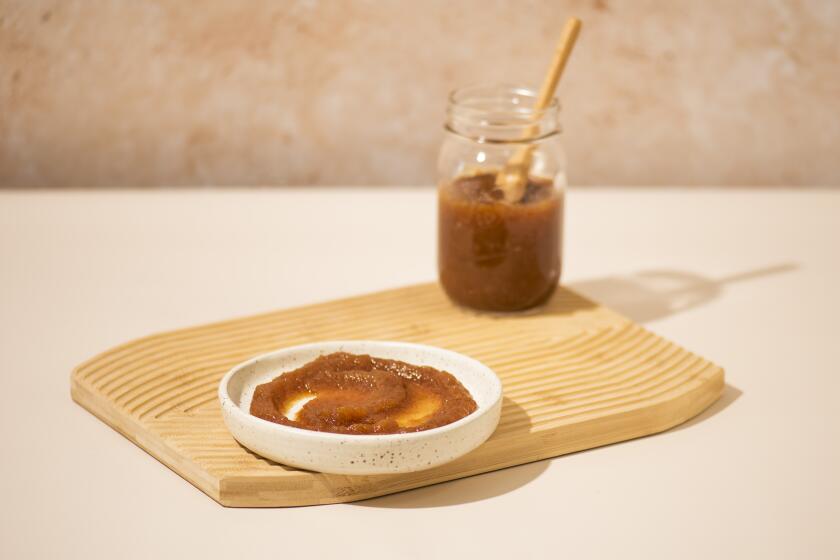Sauce for zaru tofu
Tofu gets a bum rap. Some people dismiss it as health food for vegans and hippies. Others think that it’s just a jiggly white brick with no flavor. That may be because people think of tofu only as the characterless cubes sitting cold and forlorn in the back corner of salad bar bins or those hard, joyless bricks that vegetarians bring to backyard barbecues.
It’s really a shame because tofu can be a beautiful thing, especially when it’s freshly made -- soy beans dried, soaked and boiled in distilled water, lovingly ground to a perfect pulp, boiled, coagulated with sea salt, strained, formed and wrapped still soft and warm, fresh from its milky bath.
Luckily for us, a handful of people in Southern California are obsessed with making tofu the old-fashioned way. They wake up at dawn to get the soybean grinding started. They offer their gorgeous, creamy white wares fresh daily, so that you too can experience the joys of soybean heaven.
Tofu was first made in China more than 2,000 years ago. However, we call it by its Japanese name because they were the first to popularize it in this country. The Chinese call it daufu, Vietnamese call it dauhu, and Koreans call it dubu.
Whatever you call it, the basis of tofu-making is quite simple. There are only three essential ingredients: soybeans, water and some kind of salt.
Tofu is an amazingly versatile food. It can be eaten sweet or salty, mild or spicy. It is served chilled or boiling hot, smooth like pudding or firm as an edible brick.
In addition to the fresh blocks of tofu (available in varying firmness), a surprising variety of fresh soy products are available in Southern California. Vietnamese purveyors offer soy puddings (available both hot and cold; the hot varieties are tastier), which make a dessert when topped with sweet ginger syrup. You can also find zaru tofu, served in a basket, and a soft Japanese tofu you can eat with a spoon. And if you’ve never had fresh soy milk, you’re in for a tasty surprise.
Each artisan tofu shop has its own way of making the soybean curds. Despite their differences, the one thing these little places have in common is that they are family-run businesses -- many of them hidden in some of the most unassuming of the mini-malls in the area.
--
Vietnam and Japan
The majority of small tofu purveyors in the Southland are Vietnamese. One of the best in Westminster’s Little Saigon is Dong Phung Tofu. It adds an unusual bit of vinegar to its regular tofu, which creates a slightly tangy flavor but doesn’t overwhelm the basic soybean taste. If you’re feeling adventurous you can get one of the flavored tofus (one with bits of mushrooms or one with pieces of ginger, lemon grass and chile flakes) for only 25 cents more. The tofu pudding is a warm and delicious treat, even better accompanied by the mild ginger syrup.
The ginger syrup from Thanh Son Tofu in Garden Grove has more kick. The warm pudding is smooth and soft. Even the cold pudding has a good, smooth texture.
In the San Gabriel Valley, VP Tofu (Dau Hu Vinh Phong) in Monterey Park serves tofu pudding, both hot and cold, with ginger syrup, but also flavors it with pandan, a long green leaf used in Southeast Asian cooking. Pandan tastes a bit nutty, with a grassy/ banana-leaf aroma and a bit of a floral undertone, somewhat similar to jasmine rice. VP Tofu serves its topped with a bit of coconut milk, and it’s available only on weekends.
If you’re at VP early on a weekday, though, you may want to try its fresh soy milk flavored with black sesame, which has a lovely nutty flavor.
Another good Vietnamese tofu producer, this one in the San Fernando Valley, is Vinh Loi Tofu. Kevin Tran and his wife make warm, fresh tofu at their vegan restaurant, which is tucked in a corner mini-mall in an unlikely Reseda neighborhood. Their fresh tofu has good texture, though it’s not quite as strong in soybean flavor as some of the others. Still, the fresh tofu holds its own, and their fresh soy pudding is served soft and warm with a side of the best ginger syrup.
A great Japanese artisanal maker is Meiji Tofu, which produces a wonderfully delicate and refined tofu, much like you’d find in the mountains of Japan. It’s in a little shop in Gardena with a tiny parking lot in back. Elderly Japanese women in the know go there early and bring their own plastic containers to carry their prizes home. Meiji makes several soy products, including the regular and “supreme” variety, made with 20% more soybean. Although both soft tofus are excellent, the supreme version has a thick, custard-like texture and a wonderfully rich soybean flavor.
--
China and Korea
Although you would expect to see Chinese artisans making their own tofu, in Southern California the only place that sells Chinese-style fresh tofu is the ubiquitous 99 Ranch Market chain.
It sells fresh tofus from the Sincere Co. (although the labels read “Authentic” in English). The regular tofu has a good, bean flavor but is very firm. Sincere tofu is also available fried in cubes and long rectangles. The store also carries fresh tofu from Westminster’s Dong Phung Tofu.
Fresh tofu is similarly scarce in Koreatown these days.
You used to be able to buy it from little old women hidden in the dark corners of markets. You’d find them selling from wooden tubs next to bags of biji (called okara in Japanese), a tofu-making byproduct that is high in nutritional value and is made into a hot and spicy stew by Korean grandmas. Unfortunately, the only fresh tofu available in Koreatown these days is from the soon dubu restaurants that dole out steaming stone pots full of spicy, silky tofu goodness.
You might try to get some of the restaurant women to sell you just the tofu, but they’ll look at you suspiciously, laugh, then politely refuse.
Kaeshi
In a medium saucepan, bring the mirin to a boil over high heat. Reduce to a simmer and cook 2 to 3 minutes to cook off some of the alcohol. Stir in the sugar until dissolved, then stir in the soy sauce. Cook just until the kaeshi begins to bubble (be careful that it does not boil), then remove from heat.
If the kaeshi has a film on top, skim this off with a spoon and discard, or remove it by placing a piece of plastic wrap on top (the film will stick) and discarding the plastic wrap. Cool the kaeshi, then pour into a nonreactive container with a tight-fitting lid and refrigerate overnight before using. This makes 4 1/2 cups kaeshi (more than is needed for the final sauce), which will keep, refrigerated, for several months.
Dashi stock
Place the kombu in a medium saucepan with water to cover. Soak the kombu for 20 minutes, then place the pan over high heat and bring to a boil. Add the bonito flakes and immediately remove from the heat. Set the pan aside until the liquid is cool enough to touch, at least 15 minutes.
Strain the dashi through a cheesecloth-lined sieve, squeezing until all of the liquid is removed. Pour the dashi into a nonreactive container with a tight-fitting lid. This makes 3 to 4 cups dashi (more than is needed for the final sauce), which will keep, refrigerated, for about 1 week.
Combine the kaeshi and dashi stock and serve on the side of the zaru tofu.
Get our Cooking newsletter.
Your roundup of inspiring recipes and kitchen tricks.
You may occasionally receive promotional content from the Los Angeles Times.










